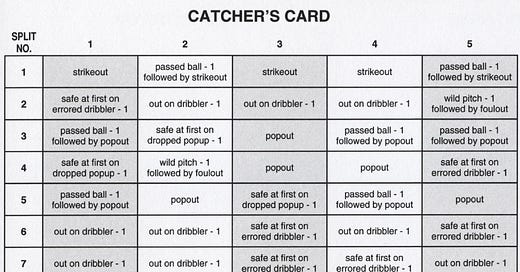The Wild Pitch And Popout
Now that I’m back to playing Strat-O-Matic in my rotation, I remembered the one thing that used to drive me nuts about the basic and advanced games.
It’s this result:
It’s all over the catcher’s X-chat in the basic game:
It’s interesting, of course, that both passed balls and wild pitches are dictated only by the catcher’s error rating.
I’m not sure why Hal Richman made that decision. But the decision that really confuses me is the “followed by foulout” you see after every one of those passed balls and wild pitches.
It’s also part of the advanced x-chart:
In fact, as hard as this might be to believe, it wasn’t until the Super Advanced game came out in 1988 that we finally had the ability to have wild pitches and passed balls without popups right afterwards.
I haven’t yet worked my way through the old Strat-O-Matic Review magazines. Does anybody know of any reason why Hal Richman set things up this way?







My best guess as to why he put popouts after wild pitches and passed balls is that he was trying to have as much precision as possible on all the rate stats (batting averages, HR/PA, BB/PA, etc.).
I think the fact that he had a d20 in the Basic Game shows how much he cared about this level of precision. If a player hit exactly .271, you can replicate that with 3d6 and a d20 (4,320 possible rolls). But with just 3d6, you have to choose between carding them as a .273 hitter (59/216) or a .269 hitter (58/216).
Once you've committed to that, you potentially mess up your math if you have results that are neither hits nor outs. I say "potentially" because there are ways to correct for this. Season Ticket Baseball has 600 possible die rolls, but roughly 12 of them don't end the plate appearance. These include passed balls, wild pitches and some rare plays. So when I calculate how many walks (for example) to put on a card based on a player's BB/PA, the denominator is 588, not 600.
Anyway ... I'm assuming that Hal's design included assumptions like "the average Catcher-X check results in a hit 30% of the time and an out 70% of the time". Since every Pitcher Card has the same number of Catcher-X checks, you can incorporate those hits and outs into your calculations when you build your cards. But the math get a bit more confusing if some of those Catcher-X results are neither hits nor outs.